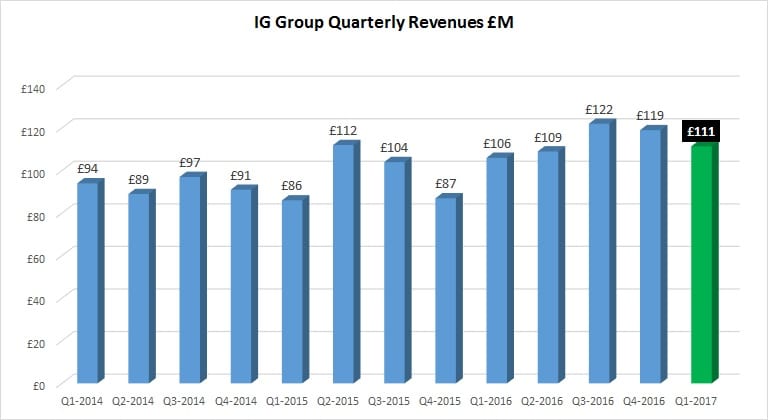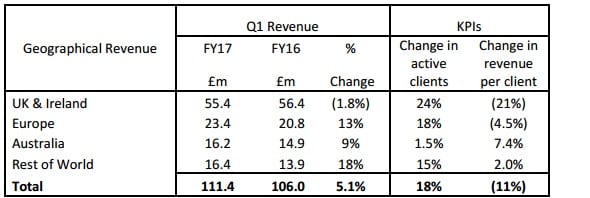Shares of online trading giant IG Group Holdings plc (LON:IGG) fell by about 3% in early trading Tuesday on the London Stock Exchange, after the company reported results for its first quarter of fiscal 2017. IG Group has a May 31 year end, so Q1-2017 is through to August 31, 2016.
Overall, the company’s revenues dropped by 7% QoQ from its fiscal 2016 fourth quarter to come in at £111.4 million. First quarter 2017 did, however, come in 5% ahead of last year’s Q1.
IG explained that the subdued trading activity was mainly in its UK arm (see chart below), where IG cut leverage and raised required client margin ahead of the late June Brexit vote.
The long term effects of Brexit seem (so far) to be positive for IG, with a very large number of new clients signing up as currency rates (especially GBP crosses) saw some wild activity in the days following the surprise #VoteLeave victory in the historic referendum. Trades from new clients were up 70% over last year.
IG Group’s revenue breakdown by geography in Q1-2017:
The complete IG press release on its Q1-2017 results reads as follows:
20 September 2016
IG GROUP HOLDINGS PLC
First Quarter Trading Update
IG Group (“IG”, “the Company”), a global leader in online trading, today issues the following Trading Update for the three months to 31 August 2016, the first quarter of its 2017 financial year. The trends and figures highlighted below refer to this period and the corresponding period last year.
IG performed relatively well in what was a challenging quarter. Revenue, at £111.4 million, was 5.1% ahead of a strong first quarter in the prior year. As announced on 24 June 2016, IG increased client margin requirements approaching and during the volatile period surrounding the UK’s EU referendum in order to preserve long term relationships and value; this had the effect of constraining client trading during this time. Financial markets through July and August became increasingly subdued and presented limited trading opportunities for both current and new clients.
Revenue was ahead in all regions except the UK, where the impact of the management actions in the period surrounding the EU referendum and the subsequent dull markets was felt most. Supported by increased effective marketing spend, the level of new client first trades was very strong. At a Group level, this metric was ahead of the prior year period by 70%, reaching a new record level, with increases in every region, and ahead of the final quarter of last year by around 30%. Unsurprisingly, the increase in the number of new clients was once again most marked in the UK and in late June. A high number of new clients beginning part way through the period, combined with the quieter end to the quarter and the ongoing growth of the stockbroking business, resulted in the lower average revenue per client in the UK.
In line with IG’s stated aim of improving client retention, the company introduced the Limited Risk Account in July and has since rolled this out across the global business. This an important step in helping some clients to manage better the risk/reward balance in their trading by guaranteeing they can never incur a debt with IG. Also in July, following recent encouraging progress in the UK, the company further progressed its aim of diversifying its product suite by extending its stockbroking offering to Australia.
Looking forward, IG has a clear strategy to deliver future growth and will continue to execute against the priorities that underpin it.

